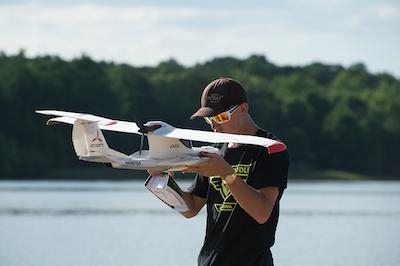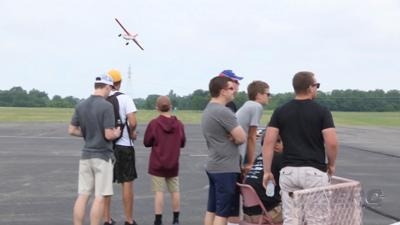Says FAA Should Distinguish Between Drones And Traditional Model Aircraft
The Academy of Model Aeronautics has released the text of its comments to the FAA concerning the Remote ID NPRM, which would require internet connectivity for aircraft in order to fulfill reporting requirements.

The AMA said in its 16-page comment document that although the organization supports the overall goal of the NPRM, the failure of the proposed rule to distinguish between different kinds of operators and different types of UAS aircraft will result in tens of thousands of model aircraft hobbyists losing access to the airspace and will impose significant compliance costs on remaining hobbyists. Fundamentally, the FAA has failed to show how the proposed rules imposed on model aircraft conducted within Visual Line of Sight (VLOS) of the operator, or co-located spotter, will improve the safety or security of the NAS.
The NPRM fails to make the distinction between the safety and security differences between VLOS operations and Beyond Visual Line of Sight (BVLOS) operations. Rather than create a set of rules that addresses the vastly different operational ability of recreational UAS, the proposed rule forces model aircraft that are designed and built to operate under VLOS to comply with rules structured for UAS designed and built to operate BVLOS. The FAA is correct in stating that UAS are going to evolve and become more complex to improve performance and capabilities, but model aircraft flying VLOS operations are fundamentally contingent on the skill of the operator providing continual input, not technology or automation.
For those hobbyists whose aircraft cannot meet the proposed rule’s technology mandates, or simply cannot afford to comply, they will be regulated to a small number of fixed sites where non-Remote ID operations could occur. Although AMA has cataloged several thousand of our local clubs’ fixed flying sites, not every hobbyist has convenient access to a fixed site. The proposed rule states explicitly that it expects the number of fixed sites to decrease over time, further limiting the modeling community’s access to the airspace. The NPRM doesn’t present any safety or security data to justify these significant limitations to the modeling community’s access to the airspace.
The NPRM incorrectly assumes that all recreational UAS operations will eventually become capable of meeting the Standard Remote ID requirement at some point without providing any data to support that assertion. In fact, the NPRM’s goal appears to be to drive the hobbyist community to advanced drone platforms or face being regulated to an ever-diminishing number of fixed sites at which to conduct VLOS operations. For more than 80 years, AMA members have been operating via VLOS and that is not going to change. It is a core element of the hobbyists’ experience. AMA members only fly VLOS and the FAA failed to consider this crucial operational fact in this rulemaking.

The proposed rule is overly burdensome and costly for model aircraft hobbyists without providing the safety or security benefits that the FAA asserts. If enacted as proposed, the rule would preclude a child flying a model aircraft in his or her neighborhood park unless equipped with Remote ID technology and a paid connection to an approved network. The rule treats this child’s afternoon in the park with a 400 gram model aircraft that her or she built from a kit as equivalent to the safety and security risk of a large commercial UAS flying BVLOS operations. The NPRM offers only generic discussions of risks associated with UAS and those comments only discuss BVLOS operations, often using only anecdotal evidence. The NPRM offers no analysis or data of the risk posed by model aircraft hobbyists or by VLOS operations. The proposed rule grossly understates the costs of compliance and fails to show the benefits accrued in adoption of the rule. For those model aircraft hobbyists who cannot or do not
want to operate at fixed sites, the monthly fees could be in the hundreds of dollars to connect to an UAS Service Supplier and cellular networks for multiple aircraft. The NPRM also fails to account for the costs associated with operating at a fixed location because most AMA sites have local club fees associated with using their facility. The reality is that the cost and requirements to fly a model aircraft will result in far fewer young people engaging in the hobby and ultimately in aviation. The NPRM also does not make clear what public safety or security benefit would be addressed by effectively prohibiting VLOS operations outside of fixed sites.
If enacted, these proposed rules would essentially eliminate a majority of the modeling community–a community that FAA has consistently cited as safe and responsible users of the airspace and one that serves as a pipeline for the next generation of aviation enthusiasts and professionals. This will negate the ability of community-based organizations (CBOs) to help the FAA educate the growing number of UAS operators.
Given that the safety and security of these vastly different types of operations need to be recognized in the final rule, AMA respectfully requests that the final rule exempt model aircraft VLOS operations from Remote ID requirements. If a blanket exemption is not provided, AMA believes that its members can address the safety and security concerns stated in the NPRM far more cost effective and under a far less onerous regulatory environment
(Source: AMA. Images from file)
 ANN's Daily Aero-Term (04.28.24): Airport Marking Aids
ANN's Daily Aero-Term (04.28.24): Airport Marking Aids Aero-News: Quote of the Day (04.28.24)
Aero-News: Quote of the Day (04.28.24) ANN's Daily Aero-Linx (04.28.24)
ANN's Daily Aero-Linx (04.28.24) Aero-News: Quote of the Day (04.29.24)
Aero-News: Quote of the Day (04.29.24) ANN's Daily Aero-Linx (04.29.24)
ANN's Daily Aero-Linx (04.29.24)




